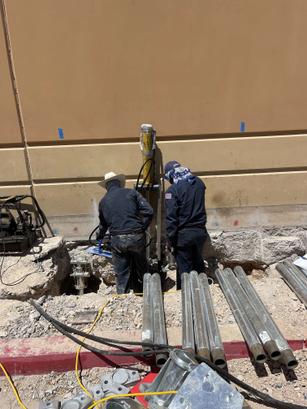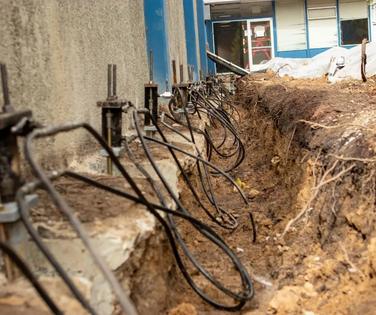Stabilize Commercial Foundations Permanently
Commercial buildings—especially tilt-up construction—are highly sensitive to foundation movement. When soils beneath footings or slabs weaken, structural loads shift, resulting in settlement, cracking, and alignment issues that impact operations and safety. Structural underpinning restores foundation stability by transferring loads to competent soils or densifying the subgrade beneath slabs and footings. Helical piles and polyurethane injection are used individually or together, depending on the conditions of the structure and site.

What Is Structural Underpinning?
Structural underpinning is a commercial foundation repair method used to stop settlement and restore the performance of load-bearing systems. It involves reinforcing or bypassing unstable soils to reestablish structural support—typically by installing helical piles to reach load-bearing strata or injecting expanding polyurethane to stabilize shallow soils and voids.
This solution is ideal for tilt-up buildings, warehouses, distribution centers, and office structures where long-term performance and operational continuity are critical.
Where Might Structural Underpinning Be Needed?

- Tilt-up buildings with settlement at wall panels
- Warehouses with cracks near perimeter footings
- Commercial slabs built on poor fill
- Multi-tenant buildings with uneven floor elevation
- Structures with additions settled away from original foundation
- Sites with expansive or moisture-sensitive soils
- Properties impacted by utility trenching or sitework
- Facilities showing early structural movement post-construction
We Recommend Structural Underpinning If You See:

- Vertical or stair-step cracking in tilt-wall panels
- Footing movement at corners or isolated columns
- Differential settlement across a structural grid
- Doors or dock bays sticking or misaligned
- Voids beneath slab edges or footings
- Exterior joints opening or shifting
- Floors sloping toward specific load-bearing walls
- Hairline cracks reappearing after patching
- Movement following excavation or drainage changes
- Settlement under mechanical pads or racking
Is Structural Underpinning Really Needed?

Yes. In commercial settings, even moderate foundation movement can impact structural performance, building code compliance, and long-term leasing value. Tilt-up construction, in particular, relies on slab and panel alignment to maintain envelope integrity.
Underpinning halts ongoing settlement and restores load transfer through stable soils. Whether through deep helical piles or targeted polyurethane injection, it’s a scalable, minimally invasive approach that preserves your structure without interrupting operations.
What Are the Advantages of Structural Underpinning?
Engineered foundation repair for active commercial sites.
Transfers Loads to Stable Strata: Helical piles reach competent soils to bypass failed zones.
Stabilizes Slabs and Footings: Polyurethane fills voids and densifies subgrade to prevent further shifting.
Supports Heavy Equipment Loads: Ideal for racking, chillers, tanks, and machinery foundations.
Minimal Business Disruption: Repairs are completed with small crews and targeted access.
Permanent Solution: Designed for long-term structural integrity and load continuity.
Common Problem Areas
- Tilt-up wall panels and perimeter footings
- Concrete slabs on fill or poorly compacted soils
- Column pads under load shifts
- Foundations near drainage or stormwater features
- Utility-impacted subgrades
- Equipment pads inside manufacturing or warehouse spaces
Nationwide Foundation Underpinning Expertise. Get Your Commercial Property Stabilized Today!
How Does Structural Underpinning Work?
A proven process tailored for commercial building conditions.
- Conduct structural and geotechnical assessment
- Identify zones of settlement, voids, or soil failure
- Determine load requirements and repair scope
- Install helical piles to torque and depth specs at footings
- Inject expanding polyurethane beneath slabs or edges as needed
- Use brackets or transfer assemblies to reengage support
- Monitor movement and confirm lift (if applicable)
- Patch injection ports and restore surface
- Provide engineering report and ongoing recommendations
Why This Is the Best Choice

- Stops settlement before major damage occurs
- Compatible with concrete tilt-up and slab-on-grade construction
- No large-scale excavation or slab removal
- Rapid installation, even in confined access areas
- Scalable for localized or facility-wide issues
- DOT- and code-compliant foundation solutions
- Backed by structural performance data
- Preserves property value and operational continuity
Contact Groundworks for Structural Underpinning
Structural Underpinning for Commercial Foundations
Groundworks delivers foundation support solutions designed specifically for commercial buildings. Whether you’re managing a tilt-up warehouse, retail space, or office facility, our helical pile and polyurethane injection systems restore structural performance—fast. Schedule an evaluation with our team today.
Names You Know Trust Groundworks with Their Toughest Foundation Issues





We want to learn about your project.
FAQs
Yes. All work can be staged without shutting down normal building operations.
Tilt-up buildings, slab-on-grade warehouses, office complexes, and other commercial structures.
Can you lift settled panels or slabs?
Depth is determined by reaching competent load-bearing strata and confirming torque specs.
Yes. It’s stable, water-resistant, and provides reliable support without chemical breakdown.
Disclaimer / Terminology
Structural Underpinning: The process of reinforcing or reestablishing a foundation’s load-bearing support.
Helical Pile: A steel deep foundation element installed with torque to reach stable soil or rock.
Tilt-Up Building: A commercial construction type where wall panels are cast on-site and lifted into place.
Polyurethane Injection: The process of injecting expanding polyurethane to fill voids or stabilize soil.
Settlement: The downward movement of a structure caused by poor or shifting soil support.